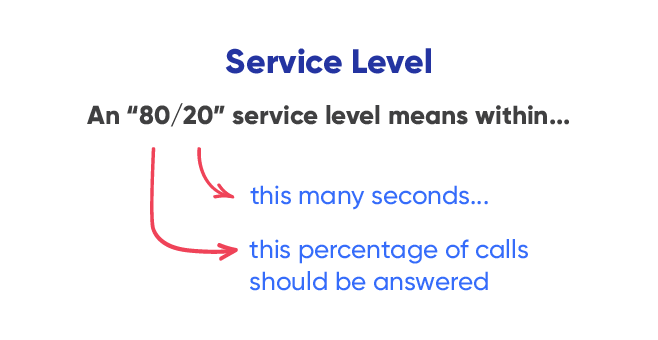When it comes to demystifying call center metrics, ‘occupancy rate’ shouldn’t be forgotten. Occupancy rate is basically a measure of how “busy” call center agents are when they are at work. It is sometimes referred to as “utilization rate.”
You might think a simpler measurement like “calls per hour” would answer this same question. But as is often the case with call centers, things get complicated quickly.
In this post, we will look into how occupancy rate is calculated, what value it adds to the vast mix of call center metrics and the problems that can arise if it is used improperly.
What is Occupancy in a Call Center?
Occupancy rate is the percentage of time that agents spend handling customer inquiries vs. waiting for calls (idle time).
It’s the most common measure of how much of their time your call center agents spend dealing with customers. For example, if your call center had an occupancy rate of 90% yesterday, that meant that your agents were handling customer enquiries for an average of 54 minutes out of every 60 minutes.
Occupancy rate is rarely calculated on an individual level; typically it will be used to determine which times of day, week or year you will need to schedule more agents to handle call volume. Not surprisingly, it often ties in closely with other KPIs like average speed of answer and service level calculations.
Why is Occupancy an Important Call Center Metric?
Occupancy rate, combined with service level can tell you if your staffing level is set properly for any given amount of time. Very important indeed! But what about occupancy on its own? It is best used as a predictor of “agent burn-out.”
There is a general consensus that high occupancy rates (above 85%) are not sustainable beyond short bursts of time. An 85% agent occupancy means agents have only an aggregate of 9 minutes of non-call time in any given hour.
Agents need time to take a breath and collect their thoughts between calls; If they don't get it, their performance suffers, followed by higher absenteeism and, eventually, agent attrition. #cctr #occupancy #cctrmanagement Click To TweetKeeping a close eye on the occupancy rate allows contact center managers to prevent agent burnout.
How to Calculate Occupancy Rate
Calculating occupancy rate isn’t as simple as it might seem.
Consider an agent who is engaged in call-related work for 45 minutes during a 60 minute period. He has an occupancy rate (or just “occupancy”) of 75%. That’s pretty straightforward.
However, we need to look deeper into the phrase “call-related,” which is the numerator of the fraction. We have to include more than just “talk time,” because sometimes agents are on hold during the conversation, waiting on another process. We also need to include work that happens after the call to “wrap-up” the transaction. This is also called after call work or ACW.
Defining the boundaries between ACW and other non-call work can be tricky. It’s important to limit this to work that is directly related to that particular call, and exclude general non-call work. This is the same thinking that goes into calculating handle time. The image below illustrates this well:

In fact, a common way to calculate occupancy rate is to add up all the handle time during the defined time period. Average handle time is typically calculated as talk time + hold time + after call work / total calls.
But, what about the denominator? We want to count how much time the agent was theoretically able to work. Many contact center systems will report available time for an agent, which counts the time an agent was logged-in but not on a call (sometimes called idle time). Armed with this number, we have our first way to calculate the occupancy rate in your contact center.
Call Center Occupancy Rate Formula
The most widely accepted formula for Call Center Occupancy is this:

Total Handle Time / (Total Handle Time + Available Time)
One danger here is to make sure that available time does not overlap with ACW time or on-hold time.
Other call centers are set up to report “logged in” time for an agent. We can use this instead of handle time if we can subtract away all non-call related activities. This time is often labeled “Aux”, “Misc” or “non-call”. That leads to an alternate formula:

The danger with this approach is to make sure agents are diligent in setting their status codes properly so that “Aux” covers all the appropriate time.
Industry-Wide Average Occupancy Rate in Contact Centers
According to CallCentreHelper.com, the average occupancy rate entered into their free online Erlang calculator from over 160,000 calculations is 83.3%. Most contact centers today aim for an occupancy rate of between 85% and 95%, depending on exactly how you measure it.
The Relationship Between Occupancy Rate and Service Level
One topic that is frequently debated in call center circles is the complicated interactions between occupancy rate and another very popular call center metric: service level. Given the same number of calls with the same handle time, meeting a higher service level will yield lower occupancy rates and vice versa. Lowering your target service level means fewer agents are needed, which raises occupancy.

Commenter Connor Bourke (of Optima WFM) summarized it well:
How to Improve Your Occupancy Rate
If you’re struggling with an occupancy rate that’s too low, there are steps you can take to improve things. Here are some ideas to explore:
Analyze call volume trends
When in doubt, always look at your historical data. Pay special attention to trends in call volume — particularly times of the day, week, and year where you see increase in demand. This will help you anticipate staffing needs.
Optimize your staffing
Once you have the foundation for your call volume forecast, it’s time for strategic scheduling. Idle time often stems from having more agents than customer calls, which can be costly for your contact center. By anticipating call volume, you can aim to have the appropriate number of agents scheduled for shifts.
TIP:
Call center outsourcing is another popular alternative for addressing low occupancy rates.
Invest in call-back technology
While call volume forecasting is useful, it isn’t 100 percent accurate. Unexpected events and crises can trigger a sudden wave of calls, catching your contact center by surprise. Call-back technology acts as a safety net in these situations by offering customers a call-back. This way, they don’t have to wait on hold, and your agents can focus on serving callers requiring immediate attention.
Assign tasks for quiet periods
During unexpected lulls, consider providing agents with additional tasks to work on. This way, your call center will get more value out of your agents’ idle time.
Is there a Difference Between Occupancy Rate and Utilization Rate?
This is a tricky one. The answer is: sometimes. Occupancy rate and utilization rate are typically used interchangeably to describe “occupancy” as we’ve outlined in this blog: time spent with customers or doing specific call-related work.
However, when contact centers draw a distinction between the two, it’s important to know exactly what is being measured in each metric. The key difference some contact centers make between the two stats is to treat the utilization rate differently. In these cases, typically, the utilization rate will consider time spent with customers PLUS extra tasks agents do throughout their days – non-customer related tasks – such as:
- Training sessions
- Coaching one-on-ones
- Team meetings
- Interviews
- Unplanned breaks and trips to the washroom
- Social event-planning
In this context, utilization rate is best used to help understand a call center’s shrinkage rate or overhead calculations.
Common Pitfalls When Calculating Occupancy Rate
One danger was already covered: looking at occupancy as a guideline for staffing without also considering service level.
Another danger is confusing occupancy with schedule adherence. They are similar metrics, but not interchangeable. This can lead to serious mistakes in forecasting and staffing.
Amy Aldridge, Customer Service Manager at Sioux Chief, shared these insights in a Linked-In discussion:
Finally, there is a danger in confusing occupancy with productivity. One agent may be able to write-up a summary or send an email faster than another. In this case, the “after call work” would yield lower occupancy for the more efficient agent, which is misleading.
If you’re measuring occupancy in your call center, you must ensure you’re tailoring it for your specific circumstances, resources, and customers to get the best results from this metric.



